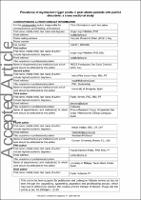Please use this identifier to cite or link to this item:
https://repositorio.usj.es/handle/123456789/1034
| Title: | Prevalence of Myofascial Trigger Points in Poststroke Patients With Painful Shoulders: A Cross-Sectional Study |
| Authors: | Villafañe, Jorge Hugo



López-Royo, María Pilar 

Herrero Gállego, Pablo 


Valdes, Kristin 
Cantero-Téllez, Raquel 

Pedersini, Paolo 

Negrini, Stefano 


|
| Keywords: | Myofascial pain; Shoulder; Stroke |
| Issue Date: | Oct-2019 |
| Publisher: | PM&R |
| Citation: | Villafañe JH, Lopez-Royo MP, Herrero P, Valdes K, Cantero-Téllez R, Pedersini P, Negrini S. Prevalence of Myofascial Trigger Points in Poststroke Patients With Painful Shoulders: A Cross-Sectional Study. PM R. 2019 Oct;11(10):1077-1082. doi: 10.1002/pmrj.12123. Epub 2019 Apr 16. PMID: 30734521. |
| Abstract: | Background: In patients with stroke, hemiplegic shoulder pain can be a major problem. One source of shoulder pain can be myofascial trigger points (MTrPs). Objective: To determine the prevalence of myofascial trigger points (MTrPs) and the correlation between MTrPs and pain and function in patients presenting with shoulder pain following a stroke. Design: Cross-sectional study. Setting: Department of Physical Therapy. Patients: Fifty patients with stroke with shoulder pain. Intervention: Not applicable. Main Outcome Measurements: The prevalence of the MTrPs located in infraspinatus, supraspinatus, teres minor, and upper trapezius was studied, using the diagnosis criteria recommended by Simons et al. The pressure pain threshold was also evaluated. Pain and function were assessed with the Visual Analogue Scale (VAS) and the Disability of the Arm, Shoulder and Hand (DASH) scale, respectively. Results: The prevalence of latent MTrPs was 68%, 92%, 40%, and 62% for supraspinatus, infraspinatus, teres minor, and upper trapezius muscle, respectively. The prevalence of active MTrPs was 34%, 50%, 12%, and 20% for supraspinatus, infraspinatus, teres minor, and upper trapezius muscle, respectively. Pain was moderately correlated with the prevalence of latent MTrPs (r = 0.35; P = .01) and active MTrPs (r = 0.31; P = .03) in the supraspinatus muscle. Disability was measured with the DASH scale and was moderately correlated with latent MTrPs in the infraspinatus (r = 0.31; P = .03) and active MTrPs of the supraspinatus (r = 0.32; P = .02). Conclusions: This study shows that the prevalence of MTrPs is high in patents following a stroke. MTrPs in this population are moderately associated with pain and function. |
| URI: | https://repositorio.usj.es/handle/123456789/1034 |
| ISSN: | 1934-1563 |
| Appears in Collections: | Artículos de revistas |
Files in This Item:
| File | Description | Size | Format | |
|---|---|---|---|---|
| Prevalence-of-myofascial-trigger.pdf | 319,2 kB | Adobe PDF |  View/Open |
This item is licensed under a Creative Commons License

